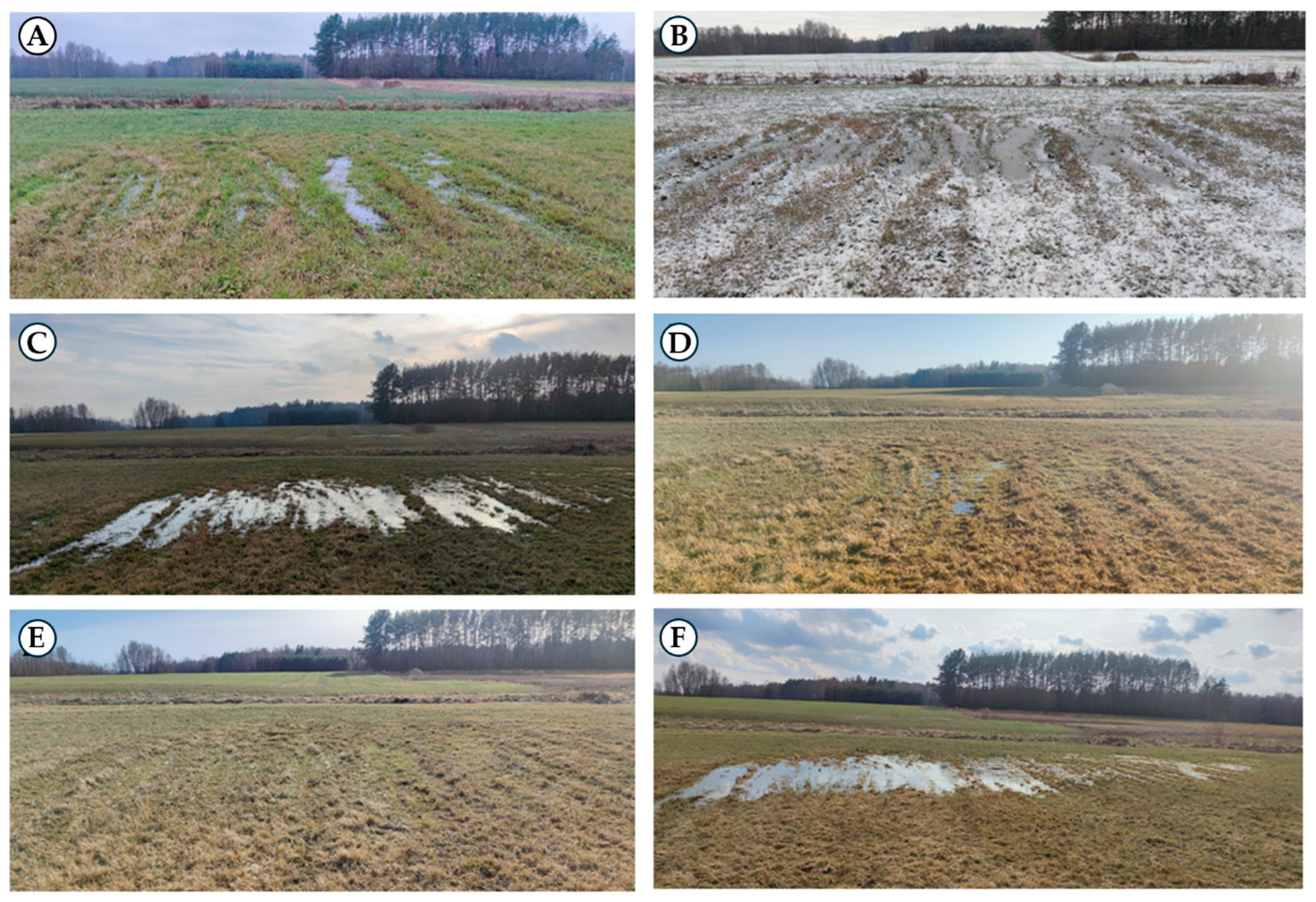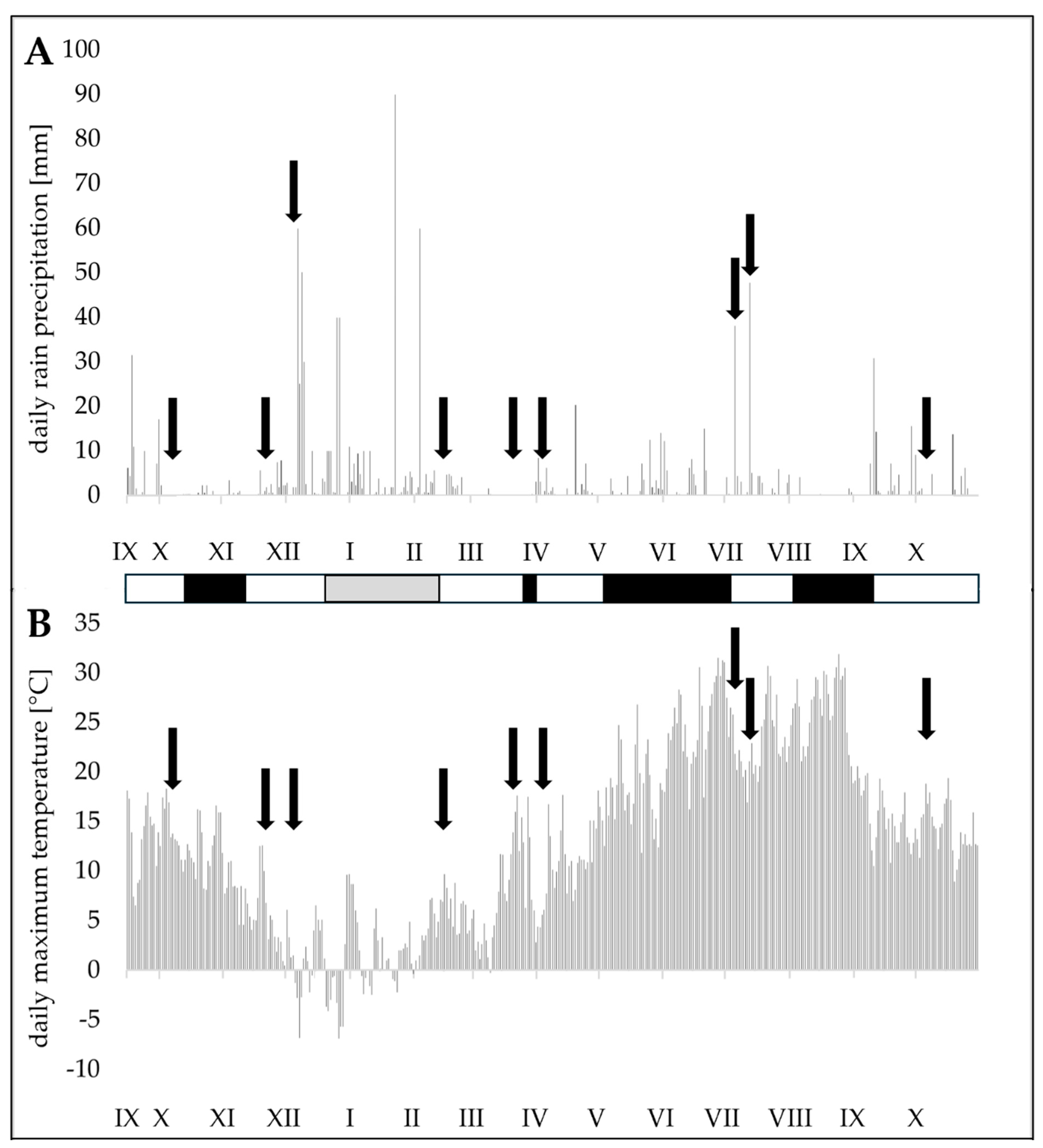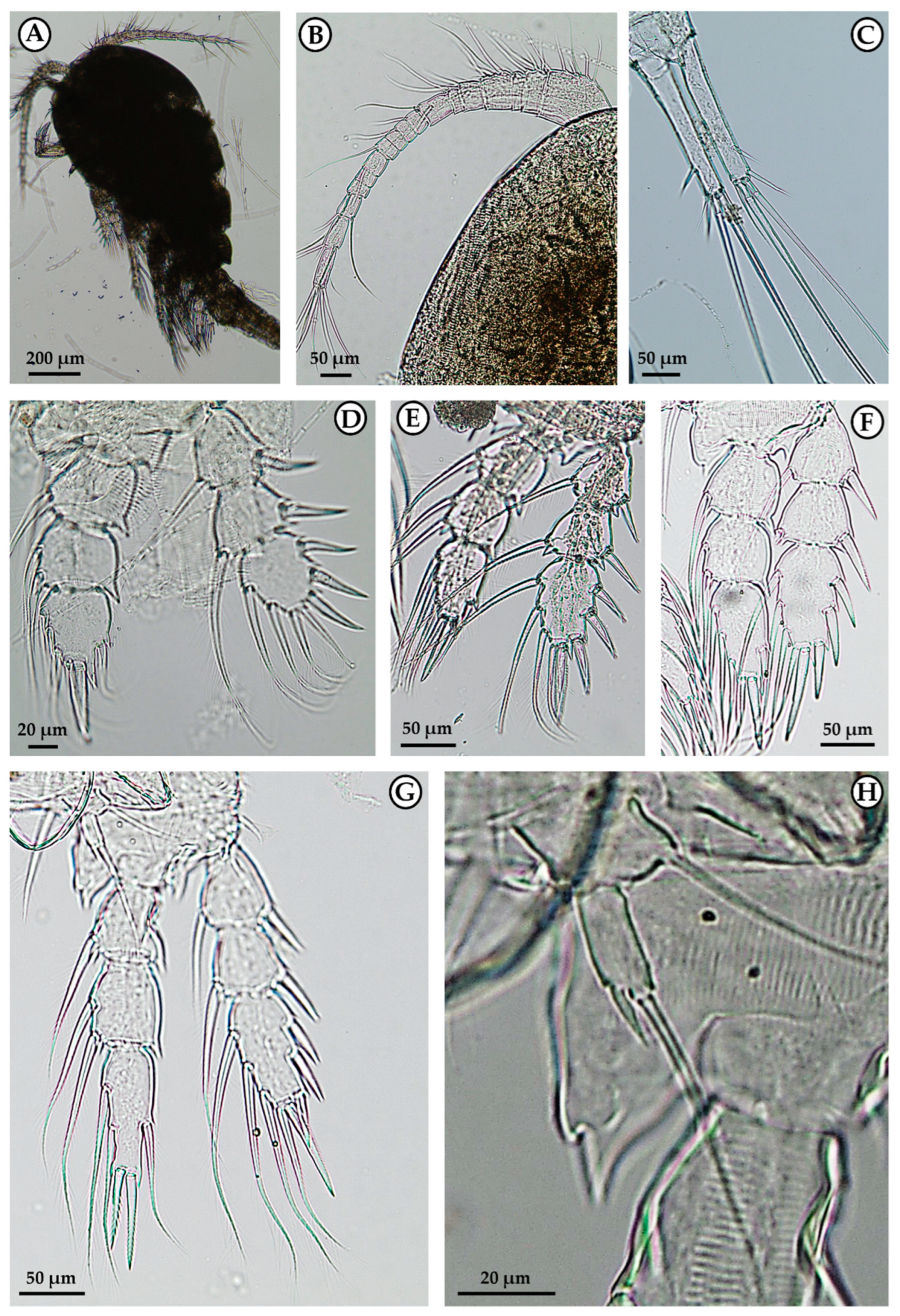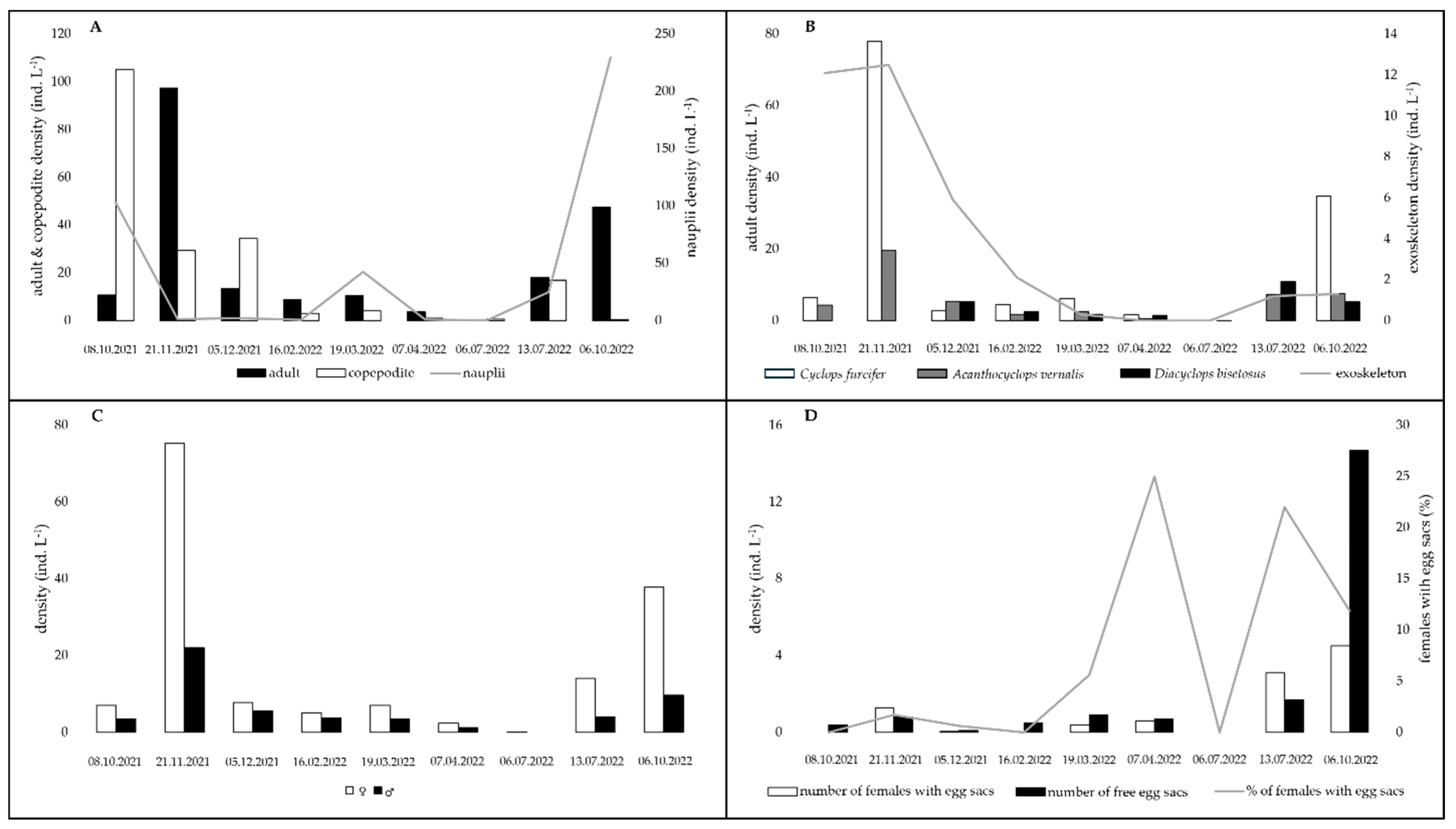Ephemeral Puddles—Potential Sites for Feeding and Reproduction of Hyporheic Copepoda
Abstract
1. Introduction
2. Materials and Methods
3. Results
4. Discussion
5. Conclusions
Author Contributions
Funding
Data Availability Statement
Acknowledgments
Conflicts of Interest
References
- Zieliński, P.; Jekatierynczuk-Rudczyk, E. Dissolved organic matter transformation in the hyporheic zone of a small lowland river. Oceanol. Hydrobiol. Stud. 2010, 39, 97–103. [Google Scholar] [CrossRef]
- Mugnai, R.; Messana, G.; Di Lorenzo, T. The hyporheic zone and its functions: Revision and research status in Neotropical regions. Braz. J. Biol. 2015, 75, 524–534. [Google Scholar] [CrossRef] [PubMed]
- Helešic, J.; Leichtfried, M.; Wagner, F.; Omesová, M. Investigations on gravel bars and the hyporheic zone in an alpine and two hercynian streams in Central Europe. Verhandlungen Int. Ver. Theor. Angew. Limnol. 2006, 29, 1511–1515. [Google Scholar] [CrossRef]
- Zhai, M.; Hřívová, D.; Peterka, T. The harpacticoid assemblages (Copepoda: Harpacticoida) in the Western Carpathian spring fens in relation to environmental variables and habitat age. Limnologica 2015, 53, 84–94. [Google Scholar] [CrossRef]
- Výravský, D.; Klímová Hřívová, D.; Bojková, J.; Horsák, M.; Zhai, M. Effects of thermal stability on microcrustacean assemblages in spring fens. Inland Waters 2023, 13, 86–100. [Google Scholar] [CrossRef]
- Galassi, D.M.P. Groundwater copepods: Diversity patterns over ecological and evolutionary scales. Hydrobiologia 2001, 453, 227–253. [Google Scholar] [CrossRef]
- Karpowicz, M.; Smolska, S.; Świsłocka, M.; Moroz, J. First insight into groundwater copepods of the Polish lowland. Water 2021, 13, 2086. [Google Scholar] [CrossRef]
- Smolska, S.; Karpowicz, M.; Świsłocka, M.; Jekatierynczuk-Rudczyk, E.; Więcko, A.; Tarasewicz, K. The patchy distribution of groundwater copepods in the lowland river valley. Ecohydrol. Hydrobiol. 2023. [Google Scholar] [CrossRef]
- Karpowicz, M. New data to the knowledge on the Harpacticoida (Crustacea, Copepoda) fauna in Poland. Fragm. Faun. 2016, 59, 87–98. [Google Scholar] [CrossRef]
- Einsle, U. Cyclops heberti n.sp. and Cyclops singularis n.sp., two new species within the genus Cyclops (‘strenuus-subgroup’) (Crust. Copepoda) from ephemeral ponds in southern Germany. Hydrobiologia 1996, 319, 167–177. [Google Scholar] [CrossRef]
- Alekseev, V.; Fefelova, F.; Dumont, H.J. Some noteworthy free-living copepods from surface freshwater in Belgium. Belg. J. Zool. 2002, 132, 133–139. [Google Scholar]
- Record, N.R.; Ji, R.; Maps, F.; Varpe, Ø.; Runge, J.A.; Petrik, C.M.; Johns, D. Copepod diapause and the biogeography of the marine lipidscape. J. Biogeogr. 2018, 45, 2238–2251. [Google Scholar] [CrossRef]
- Belmonte, G.; Miglietta, A.M.; Rubino, F.; Boero, F. Morphological convergence of resting stages produced by planktonic organisms: A review. Hydrobiologia 1997, 335, 159–165. [Google Scholar] [CrossRef]
- Belmonte, G. The suspected contradictory role of parental care in the adaption of planktonic Calanoida to temporary freshwater. Water 2021, 13, 100. [Google Scholar] [CrossRef]
- Louette, G.; De Meester, L. High dispersal capacity of cladoceran zooplankton in newly founded communities. Ecology 2005, 86, 353–359. [Google Scholar] [CrossRef]
- Michels, E.; Cottenie, K.; Neys, L.; De Meester, L. Zooplankton on the move: First results on the quantification of dispersal of zooplankton in a set of interconnected ponds. Hydrobiologia 2001, 442, 117–126. [Google Scholar] [CrossRef]
- Brendonk, L.; Riddoch, B.J. Wind-borne short-range egg dispersal in anostracans (Crustacea: Branchiopoda). Biol. J. Linn. Soc. 1999, 67, 87–95. [Google Scholar] [CrossRef]
- Cáceres, C.E.; Soluk, D.A. Blowing in the wind: A field test of overland dispersal and colonization by aquatic invertebrates. Oecologia 2002, 131, 402–408. [Google Scholar] [CrossRef] [PubMed]
- Figuerola, J.; Green, A.J. Dispersal of aquatic organisms by waterbirds: A review of past research and priorities for future studies. Freshw. Biol. 2002, 47, 483–494. [Google Scholar] [CrossRef]
- Charalambidou, I.; Ketelaars, H.A.M.; Santamaría, L. Endozoochory by ducks: Influence of developmental stage of Bythotrephes diapause eggs on dispersal probability. Divers. Distrib. 2003, 9, 367–374. [Google Scholar] [CrossRef]
- Olmo, C.; Armengol, X.; Ortells, R. Re-establishment of zooplankton communities in temporary ponds after autumn flooding: Does restoration age matter? Limnologica 2012, 42, 310–319. [Google Scholar] [CrossRef]
- Coccia, C.; Almeida, B.A.; Badosa, A.; Diniz, L.P.; Brendock, L.; Frisch, D.; Green, A.J. Hydroperiod length, not pond age, determines zooplankton taxonomic and functional diversity in temporary ponds. Ecol. Indic. 2024, 159, 111632. [Google Scholar] [CrossRef]
- Einsle, U.K. Copepoda: Cyclopoida Genera Cyclops, Megacyclops, Acanthocyclops. In Guides to the Identificaton of the Microinvertebrates of the Continental Waters of the World; Dumont, H.J.F., Ed.; SPB Academic Publishing: Amsterdam, The Netherlands, 1996; Volume 10, pp. 1–83. [Google Scholar]
- Błędzki, L.A.; Rybak, J.I. Freshwater Crustacean Zooplankton of Europe: Cladocera & Copepoda (Calanoida, Cyclopoida). Key to Species Identification, with Notes on Ecology, Distribution, Methods and Introduction to Data Analysis; Springer: Berlin/Heidelberg, Germany, 2016. [Google Scholar] [CrossRef]
- Miracle, M.R.; Alekseev, V.R.; Monchenko, V.; Sentandreu, V.; Vicente, E. Molecular-genetic-based contribution to the taxonomy of the Acanthocyclops robustus group. J. Nat. Hist. 2013, 47, 863–888. [Google Scholar] [CrossRef]
- Anufriieva, E.; Hołyńska, M.; Shadrin, N. Current invasions of Asian Cyclopid species (Copepoda: Cyclopidae) in Crimea, with taxonomical and zoogeographical remarks on the hypersaline and freshwater fauna. Ann. Zool. 2014, 64, 109–130. [Google Scholar] [CrossRef]
- Williams, P.; Whitfield, M.; Biggs, J.; Bray, S.; Fox, G.; Nicolet, P.; Sear, D. Comparative biodiversity of rivers, streams, ditches and ponds in an agricultural landscape in Southern England. Biol. Conserv. 2004, 115, 329–341. [Google Scholar] [CrossRef]
- Oertli, B.; Biggs, J.; Céréghino, R.; Grillas, P.; Joly, P.; Lachavanne, J.B. Conservation and monitoring of pond biodiversity: Introduction. Aquat. Conserv. Mar. Freshw. Ecosyst. 2005, 15, 535–540. [Google Scholar] [CrossRef]
- Szałkiewicz, E.; Jusik, S.; Grygoruk, M. Status of and Perspectives on River Restoration in Europe: 310,000 Euros per Hectare of Restored River. Sustainability 2018, 10, 129. [Google Scholar] [CrossRef]
- Pociecha, A.; Karpowicz, M.; Namiotko, T.; Dumnicka, E.; Galas, J. Diversity of groundwater crustaceans in wells in various geologic formations of southern Poland. Water 2021, 13, 2193. [Google Scholar] [CrossRef]
- Martin, P.; De Broyer, C.; Fiers, F.; Michel, G.; Sablon, R.; Wouters, K. Biodiversity of Belgian groundwater fauna in relation to environmental conditions. Freshw. Biol. 2009, 54, 814–829. [Google Scholar] [CrossRef]
- Hobbs, H.H. Diversity Patterns in the United States. Encyclopedia of Caves; Academic Press: Chennai, India, 2012; pp. 251–264. [Google Scholar] [CrossRef]
- Strayer, D.L.; May, S.E.; Nielsen, P.; Wollheim, W.; Hausam, S. An endemic groundwater fauna in unglaciated eastern North America. Can. J. Zool. 1995, 73, 502–508. [Google Scholar] [CrossRef]
- Iannella, M.; Fiasca, B.; Di Lorenzo, T.; Biondi, M.; Di Cicco, M.; Galassi, D.M.P. Spatial distribution of stygobitic crustacean harpacticoids at the boundaries of groundwater habitat types in Europe. Sci. Rep. 2020, 10, 19043. [Google Scholar] [CrossRef]
- Deharveng, L.; Stoch, F.; Gibert, J.; Bedos, A.; Galassi, D.; Zagmajster, M.; Brancelj, A.; Camacho, A.; Fiers, F.; Martin, P.; et al. Groundwater biodiversity in Europe. Freshw. Biol. 2009, 54, 709–726. [Google Scholar] [CrossRef]
- Gibert, J.; Culver, D.C. Assessing and conserving groundwater biodiversity: An introduction. Freshw. Biol. 2009, 54, 639–648. [Google Scholar] [CrossRef]
- Kalinowska, K.; Karpowicz, M. Ice-on and ice-off dynamics of ciliates and metazooplankton in the Łuczański Canal (Poland). Aquat. Ecol. 2020, 54, 1121–1134. [Google Scholar] [CrossRef]
- Svetlichny, L.; Obertegger, U. Influence of egg sacs on the swimming performance of freshwater cyclopoid copepods. J. Plankton Res. 2024, fbae007. [Google Scholar] [CrossRef]
- Gaviria, S. Checklist and distribution of the free-living copepods (Arthropoda: Crustacea) from Austria. Ann. Naturhistorischen Mus. Wien Ser. B Für Bot. Und Zool. 1998, 100, 539–594. [Google Scholar]
- Yevdokimov, N.A.; Yermokhin, M.V. Zooplankton crustaceans of ephemeral waterbodies on the territory of various natural zones in Saratov oblast. Inland Water Biol. 2009, 2, 59–66. [Google Scholar] [CrossRef]
- Pasternak, A.F.; Arashkevich, E.G. Resting stages in the life cycle of Eudiaptomus graciloides (Lill.) (Copepoda: Calanoida) in Lake Glubokoe. J. Plankton Res. 1999, 21, 309–325. [Google Scholar] [CrossRef]
- Wierzbicka, M. Distribution of Cyclopoida copepodites in the resting stage in bottom sediments of astatic reservoirs. Pol. Arch. Hydrobiol. 1972, 19, 369–376. [Google Scholar]
- Marcus, N.H.; Lutz, R.; Burnett, W.; Cable, P. Age, viability, and vertical distribution of zooplankton resting eggs from an anoxic basin: Evidence of an egg bank. Limnol. Oceanogr. 1994, 39, 154–158. [Google Scholar] [CrossRef]
- Hairston, N.G. Zooplankton egg banks as biotic reservoirs in changing environments. Limnol. Oceanogr. 1996, 41, 1087–1092. [Google Scholar] [CrossRef]
- Cáceres, C.E. Interespecific variation in the abundance, production and emergence of Daphnia diapausing eggs. Ecology 1998, 79, 1699–1710. [Google Scholar] [CrossRef]
- Brendonck, L.; De Meester, L. Egg banks in freshwater zooplankton: Evolutionary and ecological archives in the sediment. Hydrobiologia 2003, 491, 65–84. [Google Scholar] [CrossRef]
- Bruno, M.C.; Perry, S.A. Exchanges of copepod fauna between surface- and groundwater in the Rocky Glades of Everglades National Park (Florida, U.S.A.). Arch Hydrobiol. 2004, 159, 489–510. [Google Scholar] [CrossRef]
- Carver, S.; Spafford, H.; Storey, A.; Weinstein, P. Colonization of ephemeral water bodies in the Wheatbelt of Western Australia by assemblages of mosquitoes (Diptera: Culicidae): Role of environmental factors, habitat, and disturbance. Environ. Entomol. 2009, 38, 1585–1594. [Google Scholar] [CrossRef] [PubMed]
- Marten, G.G.; Bordes, E.S.; Nguyen, M. Use of cyclopoid copepods for mosquito control. Hydrobiologia 1994, 292, 491–496. [Google Scholar] [CrossRef]
- Tuno, N.; Phong, T.V.; Takagi, M. Climate change may restrict the predation efficiency of Mesocyclops aspericornis (Copepoda: Cyclopidae) on Aedes aegypti (Diptera: Culicidae) Larvae. Insects 2020, 11, 307. [Google Scholar] [CrossRef]
- Pauly, I.; Jakoby, O.; Becker, N. Efficacy of native cyclopoid copepods in biological vector control with regard to their predatory behavior against the Asian tiger mosquito, Aedes albopictus. Parasites Vectors 2022, 15, 351. [Google Scholar] [CrossRef]







Disclaimer/Publisher’s Note: The statements, opinions and data contained in all publications are solely those of the individual author(s) and contributor(s) and not of MDPI and/or the editor(s). MDPI and/or the editor(s) disclaim responsibility for any injury to people or property resulting from any ideas, methods, instructions or products referred to in the content. |
© 2024 by the authors. Licensee MDPI, Basel, Switzerland. This article is an open access article distributed under the terms and conditions of the Creative Commons Attribution (CC BY) license (https://creativecommons.org/licenses/by/4.0/).
Share and Cite
Karpowicz, M.; Smolska, S. Ephemeral Puddles—Potential Sites for Feeding and Reproduction of Hyporheic Copepoda. Water 2024, 16, 1068. https://doi.org/10.3390/w16071068
Karpowicz M, Smolska S. Ephemeral Puddles—Potential Sites for Feeding and Reproduction of Hyporheic Copepoda. Water. 2024; 16(7):1068. https://doi.org/10.3390/w16071068
Chicago/Turabian StyleKarpowicz, Maciej, and Sabina Smolska. 2024. "Ephemeral Puddles—Potential Sites for Feeding and Reproduction of Hyporheic Copepoda" Water 16, no. 7: 1068. https://doi.org/10.3390/w16071068
APA StyleKarpowicz, M., & Smolska, S. (2024). Ephemeral Puddles—Potential Sites for Feeding and Reproduction of Hyporheic Copepoda. Water, 16(7), 1068. https://doi.org/10.3390/w16071068






